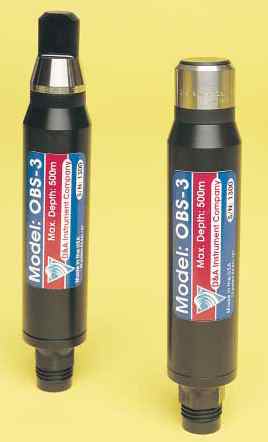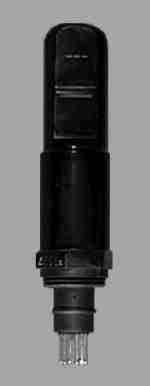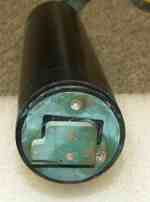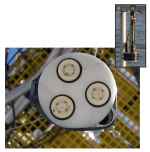|
Turbidity is a measure of the amount of suspended material in the water column. Turbidity sensors employ either optical or acoustic methods to quantify the level of turbidity. These sensors may be attached to their own datalogger, or logged as an external sensor on a Sea-Bird SeaCAT, a SonTek ADV, or a SonTek PCADP system. The sampling rate is determined by the host logging system. Turbidity data are most commonly found as variables in SeaCAT, MicroCAT, ADV, PCADP, and MIDAS files, but may occasionally be stored in a separate file.
Transmissometer
A transmissometer measures the percentage of light transmitted along a fixed path. USGS data have typically been collected with Sea Technology and WET Labs C-Star (http://www.wetlabs.com/products/cstar/cstar.htm) transmissometers (fig. 21) in 5- and 25-cm path lengths. These sensors use light from a red light-emitting diode (LED) (650-nanometer [nm] wavelength). Data collected in the 1970s and 1980s used 0.5-m path-length white-light transmissometers made by Montedoro-Whitney (Moody and others, 1987). Conversion of the observed signal to particle concentration is dependent on calibration methods, which are specific to each experiment. Transmissometers are used on moorings and bottom tripods (Bartz and others, 1978). The signals commonly decay with time as the optical windows become fouled. When the fouling during a deployment is extreme, sometimes transmissometer data may be truncated as part of the processing. In other cases, the data are left, as fluctuations may still be observed despite the decreased signal.
Optical Backscatter Sensor (OBS)
An OBS measures turbidity by sending a beam of infrared light into the water and measuring the quantity of light scattered off suspended particles and reflected back to the sensor. Calibration coefficients are then employed to determine suspended sediment concentration. OBS are more sensitive to coarse-grained particles than transmissometers and are less susceptible to fouling. USGS has used D&A Instrument Company (now Campbell Scientific) OBS-3 (fig. 22A)(https://www.campbellsci.com/obs-3plus), Seapoint OBS sensors (fig. 22B) (http://www.seapoint.com), and WET Labs Environmental Characterization Optics (ECO) sensors (fig. 22C) with antifouling wiper (http://www.wetlabs.com). WET Labs ECO turbidity sensors collect data that are not affected by colored dissolved organic matter. These sensors use ultraviolet light from an LED (700-nm wavelength). The instruments are equipped with a copper biowiper to lessen growth on the sensor.
Accuracy is dependent on calibration methods, which are specific to the experiment. OBS sensors are typically used on bottom tripods.
Acoustic Backscatter Sensor (ABS)
An Aquatec ABS (fig. 23) (http://www.aquatecgroup.com/) is a multifrequency acoustic backscatter instrument that logs profiles of backscatter intensity from sound pulses delivered at different frequencies. Use of multiple frequencies allows interpretation of the backscatter data according to different sediment-size ranges. The unit logs bursts of backscatter intensity, allowing high-resolution measurement in time and space. This system is monostatic, and the gain applied to the return signal is linear, to provide more consistent return over the length of the profile than ADCP-received signal gains, which are designed to maximize the range of the instrument. Typically, ABS are mounted on tripods facing downward with a data-acquisition scheme of sampling at 64 Hz for 18 minutes every hour, and storing 2 Hz averages for the duration of sampling.
Laser In Situ Scattering and Transmissometry (LISST)
The LISST, manufactured by Sequoia Scientific Inc., uses laser diffraction to obtain particle-size distributions of the sediment suspended in the sensing volume. This sensor provides the diameter of particles as opposed to their density. Collimated light is passed through a volume of water, where the suspended particles diffract the beams, and several ring-type detectors at the receiver are used to isolate sub-ranges of angles scattered. See http://www.sequoiasci.com/product/lisst-100x/ for additional detail.
| Click on figures for larger images.

Figure 21. A Sea-Tech Transmissometer mounted horizontally on a tripod frame. The white disks are coated with anti-foulant to prevent growth in the sensor path. |

Figure 22A. Two D&A Optical backscatter sensors (OBSs). |

Figure 22B. A Seapoint Optical backscatter sensor (OBSs). |

Figure 22C. A Wet Labs Environmental Characterization Optics (ECO) with wiper to lessen fouling by organic growth. |

Figure 23. End view of the acoustic transducers on an acoustic backscatter sensor (ABS), each of different frequency. Inset shows the side view of an acoustic backscatter sensor (ABS) mounted on a tripod. |
|